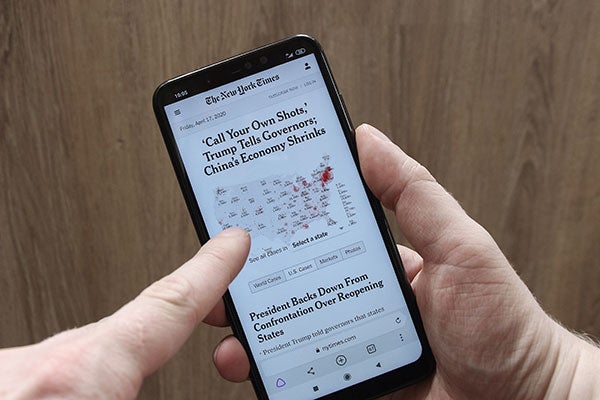
The pandemic has made The New York Times even less reliant on advertising than it was before.
The New York Times added a record 669,000 digital subscriptions in the second quarter as people sought news about the coronavirus pandemic and followed coverage of the protests after the killing of George Floyd.
The 8.4% increase in revenue from subscriptions coupled with a 55% decline in the Times’ print advertising business helped the Gray Lady reach an inflection point: The balance of NYT’s revenue is now majority digital for the first time in its history.
Although digital advertising declined less than print, it still fell 32% to $39.5 million – a softer decline than the company had predicted last quarter.
Advertising no longer a ‘growth driver’
The Times’ total subscriber count stands at 6.5 million, more than halfway toward outgoing CEO Mark Thompson’s goal of 10 million subscribers by 2025. For the Times, subscriptions account for nearly three-quarters of overall revenue and brought in $293.2 million during the quarter.
Keep your eye on those numbers. Although Meredith Kopit Levien, who will assume the role of CEO on Sept. 8, comes from an ad background, she told investors that the Times’ advertising business is unlikely to be a significant growth driver in the near term. Its display business will be under pressure for the foreseeable.
In this environment, the Times’ advertising strategy will focus on making a bigger impact with fewer ads.
Visually, the Times will sell fewer ads but with larger formats, she said, and use its first-party data in “privacy-forward” ways to better target those ads. The Times will also focus on providing insights about its audience to advertisers.
But there is one area where the Times does plan to scale up its ads business, and that’s audio. It bought Serial Productions during the quarter, and entered a strategic alliance with This American Life. Starting next year, the Times will sell Serial’s podcast ads.
Audio also serves as an important part of the Times’ subscription funnel. “[We are] big believers in the power audio can have in building deeper connections to our audience,” Levien said.
AdExchanger Daily
Get our editors’ roundup delivered to your inbox every weekday.
Daily Roundup
As had been reported in June, the Times laid off 68 people in its advertising business during the quarter and shut down its experiential marketing agency Fake Love as it resized for a future with advertising playing a smaller role.
The Times also spent less on its own advertising. The relentless news cycle led to a huge organic increase in subscriptions, and the company was able to pull back on its sales and marketing costs by 36% during the quarter, though the Times expects to resume more paid marketing later this year.
Tougher on platforms
As The New York Times takes more control over its own destiny, it’s also shoring up, evaluating – and ending – the way it works with platform.
For example, The New York Times ended its partnership with Apple News in Q2.
Readers should be clear that they’re consuming content from the Times, Levien said, and the way that content is presented needs to be “named and differentiated.” And the Times “must be sufficiently compensated” in order for it to put content on platforms, she said.
Facebook News fits that criteria for the moment. Though the Times’ “Other Revenue” segment declined 5% to $42.8 million during the quarter, licensing revenue from Facebook News was an area of strength.
Beyond digital platforms and audio, TV and streaming platforms are the next frontier for the Times.
“The Weekly” show runs on FX and Hulu, and the documentary “Father Soldier Son,” created by Times journalists, is available on Netflix.
The 1619 Project, a Pulitzer Prize-winning project about the history of slavery, was not only was downloaded an additional 4 million times in the wake of national conversations about racism, but is slated to become a limited series for Amazon Studios in partnership with Oprah Winfrey.













